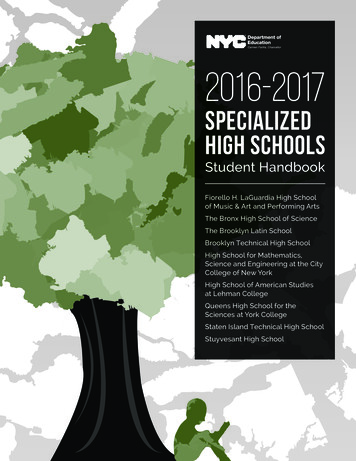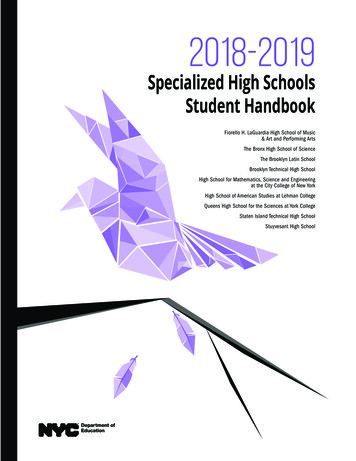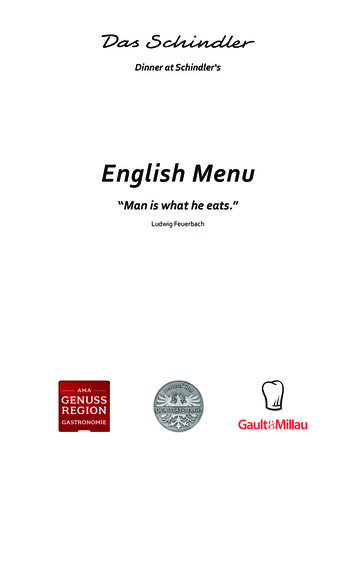
Transcription
Menu Plan For High School Football PlayerTartan Sr. High in Oakdale MNNatalie KosselKinsey RohlingFeng Ding1
1. Introduction . 32. 7-Day Meal Plan for High School Football Players. 62.1 Day 1 (Monday) . 62.2 DAY 2 (Tuesday) . 72.3 Day 3 (Wednesday) . 92.4 Day 4 (Thursday) . 102.5 Day 5 (Friday) . 112.6 Day 6 (Saturday) . 122.7 Day 7 (Sunday) . 133. Observation . 153.1 Observation Site 1 . 153.2 Observation Site 2 . 173.3 Observation Site 3 . 204. Nutrient Analysis . 225. Menu Costing for One Day . 256. Discussion and Summary . 287. Appendix . 318. References .322
1. IntroductionDiet and exercise are two very important aspects in the health and performance of highschool football players. There are many contributing factors that can greatly affect what and howmuch football players in high school can eat such as age, gender, body size , weather, educationlevel, and amount of time and skill level of the player. High school football players age can rangefrom 14-18 years old males. This age range indicates that most high school football players aregoing through puberty and thus have higher nutrient needs that have to be able to support hormonechanges and growth in the body, in addition to their daily energy expenditure.1 The recommendeddietary intake of calories for males ages 14-18 years old is 2000-3200 calories per day, with about225-325 grams of carbohydrates, 56-78 grams of fat, and 50-150 grams of protein.2 However,males ages 14 to 18 that play football should be getting between 3400-4500 calories, 600-800grams of carbohydrates, 70-130 grams of fat, and 130-180 grams of protein per day.1 Becausehigh school football players are participating in more, higher intensity activities, they need evenmore nutrients than the average high school male going through puberty.Body size is another contributing factor that greatly affects the nutritional needs of a highschool football player. Caloric and nutrient needs generally increase with height, weight, andBMI because they require more energy to maintain their tissues.3 As mentioned before, most highschool football players are going through puberty and growing taller and heavier, thus have highernutritional needs. High school football players specifically have more muscle mass than theaverage teenage boy, which means the amount of calories they burn is higher, therefore they mustalso consume more calories to meet their nutritional needs.3Education level and economic status can also determine diet and knowledge of nutritionalneeds for high school football players. Because these football players are in high school, it isassumed that their knowledge of nutrition has mainly come from classes at school. Ninety-ninepercent of public schools offer some sort of nutrition education to all students.4 Over 90 percent ofthe nutrition education high school students receive cover topics such as relationship between dietand health, choosing healthy foods, MyPlate, and the Dietary Guidelines.4 However, manyschools don’t cover the extra nutritional needs of high school athletes. This means that high3
school football players lack a lot of knowledge and skill pertaining to their own nutritional needs,making it difficult for them to make the proper meals that meet these needs.The specific high school football team we are studying is based out of Tartan Sr. High inOakdale, MN. The normal football season takes place in the Fall season from September toNovember, with the average temperature ranging from 38-46 degrees Fahrenheit in Minnesota.5However, in Minnesota, it can also get below freezing (32oF) during the Fall football season.5This is important because climate and temperature can affect how many calories the footballplayers are burning and how much energy they need. The American Council on Exercise foundthat the body expends more calories in hot weather (68oF-86oF) than in cold weather (32oF-50oF).6This means that football players would require more calories during hotter temperatures thancolder temperatures. In Minnesota, colder weather would not greatly affect the diet of a highschool football player. However the American Council on exercise also found that if the weather iscold to the point of shivering, the body does need more energy (about 400 calories) to maintainbody heat.6 Since it can get below freezing during football season in Minnesota, on very cold daysfootball players should consume about 400 more calories in order to maintain body temperatureand not get fatigued.Because high school football players have a busy schedule with practices/games and lack theskills to prepare their own meals, many of them depend on school lunches to help them meet theirnutritional needs. School lunches have been designed to help students maintain a balanced diet4,but they only take into account the nutritional needs of the average student and not those of a highschool football player. The USDA requirements for a school lunch for grades 9-12 are 750-850calories, 5 cups of fruit, 5 cups of vegetables, 10-12 cups of grains, and 10-12 ounces of meat.7This means that many high school football players are not getting their nutritional needs from theirschool lunches and thus depend largely on the meals they eat from home. However, the averagehigh school football player attends at least two games per week and two hour practices every dayafter school with an extra practice on Saturday.8 Trying to get a proper diet in with this hecticschedule is very difficult for high school football players and because of these time restraints, it iseven more difficult for them to get their daily nutritional needs.Considering all these factors, the eating habits of the Tartan Sr. High football team are mainlyaimed at getting in their required calories, carbohydrates, protein, and hydration needs. They do4
this by trying to eat a high calorie breakfast every morning, eating at least five times a day toreplenished calories, eating every three hours to replenish calories, and drinking plenty of water.Following these basic guidelines will help Tartan Sr. High football players meet their dailynutritional requirements so that they can perform at top level, while remaining healthy.5
2. 7-Day Meal Plan for High School Football PlayersBreakfast is usually eaten at home and is prepared by either themselves or their parents.Occasionally breakfast is eaten at school and is provided by the school. Snacks during the schoolday are eaten during breaks in class and study hall hours. These are brought from home. Snacks onthe weekends are eaten at home. Lunch is eaten at school and is provided by the school. Onweekends lunch is prepare by the student or their parents and is eaten at home. Sometimes thefootball players will go out for lunch, on weekdays or weekends. Dinner is always eaten at homeand is prepared by the parents. Water is also drunk throughout the entire day.2.1 Day 1 (Monday)Total Calories 4007Breakfast (628 calories)-Eaten at home before school2 cups red berries cereal (62g) (220cal)1 banana (118g) (105cal)2 eggs, scrambled (94g) (199cal)1 cup low-fat milk (244g) (102cal)Snack (334 calories)-Brought from home. Eaten between classes.2 graham crackers (28g) (118cal)2 scoops nutritional shake mix chocolate (38g) (135cal)1 peach (98g) (38cal)1 cup of waterLunch (810 calories)-Went out to lunch with friends1 cups of vegetable juice (340g) (70cal)Subway5 oz sliced roast beef (143g) (275cal)2 slices whole-wheat bread (75g) (231cal)6 slices tomatoes (12g) (30cal)6 slices cucumber (21g) (3cal)3 leaf lettuce (30g) (6cal)Salad½ cup of potato (144g) (164cal)½ cup of vegetable (207g) (33cal)Snack (251cal)-Brought from home. Eaten during study hall period.1 cup lowfat yogurt (226g) (180cal)1 serving blueberries (125g) (71cal)6
1 cup of waterPre-practice snack (607 calories)-Brought from home. Eaten after school in hallway or locker room.1 protein bar (50g) (190cal)64 fl oz Gatorade (1899 g) (417cal)(also throughout practice)Post-practice snack (582 calories)-Brought from home. Eaten in locker room or in car on way home.1 peanut butter an jelly sandwich (75g) (343cal)1 orange (140g) (69cal)1 cup grape juice (240g) (170cal)Dinner (797 calories)-Eaten at home. Prepared by parents.1 cup of orange juice (248g) (118cal)6 oz of grilled chicken (196g) (217cal)1 baked potato (299g) (278cal)1t. light butter (14g) (45cal)¼ cup of broccoli (39g) (14cal)¼ cup of carrot (30g) (13cal)¼ cup of corn (39g) (31cal)¼ cup of green beans (31g) (11cal)1 wheat roll (28g) (76cal)2.2 DAY 2 (Tuesday)Total Calories 4050Breakfast: (577 calories)-Eaten at home at breakfast table. Prepared by parents.Omlette:3 eggs (282cal)3 tablespoons of diced Tomatoes (10cal)¼ cup Spinach (3 cal)¼ cup cheddar Cheese (100 cal)3 tbsp Red Onion (12 cal)1 Teaspoon olive oil (40 cal)1 slices of whole grain bread (70 cal).5 tbsp butter1 cups of 100% orange juice (60 cal)Snack: (235 calories)-Brought from home. Eaten between classes.1 cup Trail mix: a blend of raisins, nuts, cranberries, sunflower kernels, and pumpkin seeds- 130calories (28g)7
1 Banana (105 calories) (118g)3 cups Water (throughout day)Lunch: (714 calories)-School lunch. Eaten in the cafeteria.Sandwich:2 slices of whole grain bread (140cal) (56g)4 slices turkey (80 cal) (45g)¼ cup shredded lettuce (2cal) (15g)1 tomato (16cal) (91g) - for sandwich and salad2 slices provolone cheese (140cal) (38g)1 tablespoon mayo (90cal) (13g)Salad:1 cup Iceburg lettuce (7cal) (55g)¼ cup raw onions (12cal) (28g)¼ cup raw cucumber (4cal) (26g)2 tbsp sunflower seeds (93cal) (16g)1.5 tbsp Light Italian dressing (40cal) (23g)1 cup skim milk (90cal) (250g)Snack: (496 calories)-Brought from home. Eaten during study hall period.4 tbsp Peanut butter (380 cal) (64g)1 Apple (116 cal) (223g)3 cups Water (throughout day)Pre practice snack: (695 calories)-Brought from home. Eaten after school in locker room.Power/protein bar (200cal) (78g)64 fl oz Powerade blue (426cal) (1920g) (also throughout practice)1 Orange (69cal)Post practice snack (30 min after practice) (196 calories)-Eaten at home before dinner.6 ox nonfat vanilla yogurt (91cal) (170g)1 cup strawberries (15cal)¼ cup Granola (90cal) (27g)Dinner: (1079 calories)-Eaten at home at dinner table with family. Prepared by parents.4oz whole grain pasta (420cal)½ cup red meat sauce (109cal) (125g)1 grilled chicken breast (282cal) (172g)Olive oil2 cups cooked green beans (88cal) (250g)Butter8
2 cups skim milk (180cal) (500g)2.3 Day 3 (Wednesday)Breakfast:3 pancakes4 Tbsp Maple syrup1 banana1.5 cups apple juiceSnack:1 cup pretzels3 Tbsp natural peanut butterWaterLunch:1, 3x4 slice of lasagna Pasta noodles Ricotta cheese Mozzarella cheese Parmesan cheese Ground beef Marinara sauce2 slices of whole grain bread2 tbsp butter1 tbsp garlic powder1 cup steamed broccoli1 cup raspberries1 cup skim milkSnack:1 cup popcorn1 cup mango1 cup WaterPre-practice snack:2 cups of protein shake¼ cup blueberriesPost-Practice snack:9
16 oz Powerade¼ cup sunflower seed kernels1 appleDinner:1 cheeseburger 1 slice Cheddar cheese 1 bun ½ cup lettuce ¼ cup diced tomatoes 1 tbsp Ketchup1 baked potato 2 tsp. Butter Dash of Salt2 cup steamed cauliflower1 cup skim milk1 medium chocolate chip cookie2.4 Day 4 (Thursday)Breakfast:3 eggs over easy2 slices whole grain toast1 Tbsp butter1 cup orange juice½ cup raspberriesSnack:1 cup strawberry yogurt¼ cup granolaLunch:Chipotle burrito Large Tortilla Chicken Black beans Tomatoes (pico salsa) Cheese Lettuce Sour cream½ cup Tortilla chips3 Tbsp Guacamole1 cup Lemonade10
Snack:½ cup crackers3 Tbsp HummusPre-practice snack:16 oz Gatorade1 protein barPost-Practice snack:1 banana1/2 cup raisinsDinner:1 serving of salmon Cooked in 2 tbsp Olive oil1.5 cups quinoa2 cups cooked asparagus1.5 cups skim milkAfter dinner snack:2 Tbsp Nutella½ cup pretzels2.5 Day 5 (Friday)Breakfast:2 cups Oatmeal- with dash of cinnamon and brown sugar1 apple¼ cup strawberries1 cup orange juice1 slice of whole grain toast- with butter and cinnamonSnack:½ cup Almonds½ cup Kale chipsLunch:1 Grilled chicken breast1.5 cup Mashed potatoes1.5 cup Green beans1 cup skim milkSnack:¼ cup Dried fruit¼ cup Celery11
2 Tbsp peanut butterPre- Game snack:1 Protein bar1 banana64oz Gatorade- throughout the gamePost- Game Snack:2 Rice cakes2 Tbsp peanut butter1 banana1-3 cups WaterDinner:3 medium slices Pizza Pizza sauce Shredded cheese Chicken TomatoesSalad 2 cups spinach ¼ cup diced Tomatoes 2 tbsp Onions ¼ cup chopped Cucumber ¼ cup Croutons 2 Tbsp French dressing1 cup milk12oz soda2.6 Day 6 (Saturday)Breakfast:3 slices French toast4 Tbsp maple syrup1 cup strawberries1 cup chocolate skim milkSnack:¼ cup Raw Carrots¼ cup Raw broccoli3 Tbsp Ranch dressingLunch:Grilled Chicken wrap12
1.5 cup Grilled chicken 1 large Whole wheat tortilla ¼ cup Tomatoes 2 tbsp Onions ½ cup Lettuce½ cup sugar snap peas½ cup pasta saladSnack:1 Whole grain bagel2 Tbsp cream cheese1 applePre-lifting (practice) snack:1 apple3 Tbsp peanut butter16 oz poweradePost-lifting (practice) snack:1 banana1 granola bar1-3 cupsWaterDinner:1 6oz Steak1 Baked potato 1 tbsp Butter Dash Salt1.5 cups cooked peas1 cup skim milkDessert:½ cup Ice cream2.7 Day 7 (Sunday)Breakfast:3 eggs- scrambled2 Slices of whole grain toast1 Tbsp butter1 Grapefruit1 glass of Apple Juice13
Snack:2 beef meat sticks (0.56oz)¼ cup cheddar cheese5 whole grain crackersLunch:1 grilled cheese2 slices whole grain bread2 slices of provolone cheese (2oz)2 slices cheddar cheese1 Tbsp butter2 cups of tomato soup1 cup steamed carrots1.5 glasses of skim milkSnack:1.5 cup vanilla yogurt¼ cup blackberries¼ cup granolaDinner:1/2 cup grilled chicken2 Tbsp teriyaki sauce1 cup of brown rice1 cup edamame1 cup cooked green beans1 cup skim milk14
3. Observation3.1 Observation Site 1Date: 10/17/2014Location of the meal: schoolTime of meal: Pre-practice snack (2:30pm)Observer: Kinsey RohlingMeal Consumption QuestionsThese questions should be addressed during the observation to obtain as much information aspossible to disseminate to your group as well as discuss your menu and the success in theSummary section of the paper.1. Who is present at the meal (e.g. family, friends, alone, etc.)?The whole football team is present (varsity and jv), along with four football coaches and afew other students/friends.2. Duration of meala. Is the time allowed enough time to eat all components of the meal? (This should beactual time that is allowed when the food is available not including waiting time forfood.)Most players consumed their pre-practice snack about an hour before practice,some even earlier. It took an average of 3 minutes for everyone to consume theirsnack.b.Is the person allowed to dismiss themselves from the table early?The players did not eat at a table. They all ate their snacks at various times at theschool. Some ate in the cafeteria, most ate their snacks outside their lockers beforegoing to the locker room for practice.3. How is the food served? What type of dishes (reusable, disposable)? Are plate/bowl/eatingand serving utensils standard types and sizes?15
The food and drinks were all pre-packaged and brought from home by the players. Therewas powerade available from a vending machine at school a couple players used. All theplayers ate some form of protein/protein bar before practice that was pre-packaged anddrank about 16oz of a sports drink.4. Who served the food?The food was not served by anyone; it was brought from home by the players.5. How the food was served (pre-portioned, self-serve, etc.)?The food was pre-packaged, so it was also pre-portioned. However some players did notconsume their entire snack before practice.6. Who determines portions (pre-portioned, self-serve, serving cups, etc)?The portions were pre-packaged and pre-portioned, but not all players consumed theirentire snack, so the portions were also self-serve because the players decided how muchthey wanted to eat.7. Menu – what foods are served?There was no actual menu, but the coaches encourage their players to eat a protein bar witha little bit of sports drink before practice. Most players consumed a protein bar with atleast 20g of protein with either Gatorade/Powerade or water.a. How are items served, cooked or raw, baked or fried (add as much detail aspossible)?The items were all pre-packaged and uncooked. The protein bars were in awrapper and the drink was from a bottle or water fountain.b. Comment on the most, least popular items? Were their items not taken or tossedexcessively?Since the players brought their own snack, they chose items they really liked, sovery little was thrown away or not eaten.I asked the players their favorite flavors of protein bars and sports drink. All theplayers liked chocolate and/or peanut butter flavored protein bars, none of themliked fruit in their protein bars. The most popular sports drink flavor wasblue/blueberry and the least favorite was purple/grape.8. Are there any distractions present during the meal?16
The whole team was talking to each other and friends while eating their snack. Therewere also other school activities getting started while they were eating. Some players didhomework while eating their snack. Some players also snacked while their coaches wentover plays and their practice plan for that day.9. Other information of interest concerning the meal:All the players ate only one protein bar before practice.The players consumed between 8oz-16oz of sports drink or water before practice.Two players did not consume any liquid before practice.3.2 Observation Site 2Date: 10/21/14Location of the meal: Tartan Sr. HighTime of meal: Lunch (12:16pm)Observer: Kinsey RohlingMeal Consumption QuestionsThese questions should be addressed during the observation to obtain as much information aspossible to disseminate to your group as well as discuss your menu and the success in theSummary section of the paper.1. Who is present at the meal (e.g. family, friends, alone, etc.)?Friends; the whole varsity football team eats together with other friends present also.There are also teachers and faculty present during lunch, but they are watching the studentinstead of eating with them.2. Duration of meala. Is the time allowed enough time to eat all components of the meal? (This should beactual time that is allowed when the food is available not including waiting time forfood.)The school lunch period at Tartan is 27 minutes long; but by the time the wholeteam got their lunch and started eating, there was about 17-24 minutes left of thelunch period. The whole football team was done eating 12 minutes after they satdown with their food, so there was more than enough time for everyone to eat.17
b.Is the person allowed to dismiss themselves from the table early?Students are to stay in the lunchroom for the whole lunch period, until the bell ringsfor them to go back to class.3. How is the food served? What type of dishes (reusable, disposable)? Are plate/bowl/eatingand serving utensils standard types and sizes?Above is a picture of what a lunch tray at Tartan looks like; they are disposable Styrofoamtrays that come with a plastic spoon, fork, and knife. The food is served cafeteria stylewith three main lines to choose from; main line, ala carte, and salad bar. There is also asmall snack line that offer foods such as cookies, brownies, candy, trail mix, granola bars,pop, etc. Most of the football player chose the ala carte line which was serving pizza orhamburger, French fries, peaches, green beans, and breadstick. Some also went to themain line, which was serving shrimp poppers with green beans, macaroni and cheese ormash potatoes, and peaches. None of the players went to the salad bar line. Almost ofthe players asked for/bought extra food.4. Who served the food?The food was served by cafeteria workers. The salad bar line allowed students to picktheir own salad, sandwich, or soup along with a choice of fruit and serve themselves.5. How the food was served (pre-portioned, self-serve, etc.)?The food is pre-portioned, but the students are able to ask for extra (most football playersasked for extra food).The salad bar is self serve, but all the salads, sandwiches and soups are pre-made andpre-packaged. The fruit served at the salad bar is all raw.6. Who determines portions (pre-portioned, self-serve, serving cups, etc)?The school lunch program and faculty determine the minimum portions of the schoollunches. They determine these portions according to the USDA’s National School Lunchprograms. However, students can also determine their own portions by asking for more orless food. According to the USDA the minimum servings of various foods are 1 cup offruit, 1 cup of veggies, 2 oz of grains, 2 oz of meat, and 1 cup of milk.7. Menu – what foods are served?18
a. How are items served, cooked or raw, baked or fried (add as much detail aspossible)?In the ala carte line, the pizza was baked, the French fries were baked, the breadstick was baked, the green beans were boiled, the hamburger was grilled, and thepeaches were canned with water.In the main line the shrimp poopers were baked, the mac and cheese was boiled andcooked, the mash potatoes were cooked, the green beans were boiled, and thepeaches were canned with water.In the salad bar all the salad and sandwich items were raw, except for the grilledchicken on top of some of the salads. The soup was all cooked and served hotIn the snack line all food is pre-packaged and some items are baked such as thecookies and brownies.b. Comment on the most, least popular items? Were their items not taken or tossedexcessively?The most popular meal was the pizza, French fries, green beans, and peaches;however most of the players threw away the green beans. The players that got themain line shrimp poppers meal also threw away a lot of green beans.None of the players got any salad bar items, so these items were the least popularamong the varsity football team.Since the players had extra time after finishing their meal, many of them went to thesnack line to buy more food. Popular items they bought were cookies, candy, andslushies.Many of the players also bought two milks and drank both of them completely.The most popular milk was 2%, then chocolate, then skim.8. Are there any distractions present during the meal?The players distracted each other by talking, but it did not stop them from eating. Therewas also a short announcement (about 3 minutes) in the middle of the lunch period about afundraiser going on for the school.The cafeteria was also very loud, but this didn’t seem to distract any of the players orstudents.9. Other information of interest concerning the meal:Many of the players also got condiments with their meals such as ketchup, mustard, salt,pepper, tartar sauce, and ranch.No football players brought lunch from home this day.19
3.3 Observation Site 3Date: 10/25/2014Location of the meal: Taco John’sTime of meal: After football practice (6:30pm)Observer: Kinsey RohlingMeal Consumption QuestionsThese questions should be addressed during the observation to obtain as much information aspossible to disseminate to your group as well as discuss your menu and the success in theSummary section of the paper.1. Who is present at the meal (e.g. family, friends, alone, etc.)?Twelve of the varsity players and a few of their friends were present. There were otherpeople in the restaurant, but they weren’t eating with the group.2. Duration of meala. Is the time allowed enough time to eat all components of the meal? (This should beactual time that is allowed when the food is available not including waiting time forfood.)The group was not a specific time schedule for this meal. The group was at therestaurant for about an hour, but everyone was finished eating after about 25minutes.b.Is the person allowed to dismiss themselves from the table early?The group was allowed to dismiss themselves at whatever time they finished.Some of the guys left before the whole group was finished, which didn’t seem tobother anyone else.3. How is the food served? What type of dishes (reusable, disposable)? Are plate/bowl/eatingand serving utensils standard types and sizes?Since the food was eaten in the restaurant, it was served on plastic trays. The tacos andburritos were individually wrapped in tinfoil-like paper, the potato oles (tater-tots) wereserved in disposable bowls, and all the condiments were in plastic packets or plasticcontainers. All the utensils were also disposable. The serving sizes are larger, butstandard for fast food.4. Who served the food?The food was made and served by Taco John’s employees.20
5. How the food was served (pre-portioned, self-serve, etc.)?The food was all pre-portioned by the Taco John employees according to Taco John’srecipes.6. Who determines portions (pre-portioned, self-serve, serving cups, etc)?The portions are determined by Taco John’s corporation; they make standard recipes thatall Taco John locations and are pre-portioned for customers.7. Menu – what foods are served?a. How are items served, cooked or raw, baked or fried (add as much detail aspossible)?All the meat is cooked on a flat-top grill or fried, the potato oles are deep fried, thevegetables and cheese on the tacos/burritos are raw, and the chirros and donut bitsare also deep fried. They also have an option for nacho cheese, which is keptwarm in a nacho cheese dispenser.b. Comment on the most, least popular items? Were their items not taken or tossedexcessively?The most popular items ordered were tacos, burritos, potato oles, nacho cheese, andpop. One person ordered nachos. None of the group ordered quesadillas, tacosalads, mexi rolls, desserts, or chicken wings. No one had water. No food wasthrown away, it was all eaten.8. Are there any distractions present during the meal?People coming in and out of the restaurant, ordering food, getting up to refill pop (thesethings didn’t seem to distract the group that much). There was a lot of talking and noisealso present in the restaurant; I think the talking amongst the group was the biggestdistraction and slowed down eating.9. Other information of interest concerning the meal.Most of the football players got nacho cheese to dip their potato oles in.All the football players got regular pop.Of the players that ordered tacos, the minimum amount of tacos ordered and eaten was fiveand the most was eight. Of those who got burritos, the minimum ordered was two and themost was three.All football players got a side of potato oles.Popular condiments used were sour cream, nacho cheese, and taco sauce.The restaurant was kind of messy, with dirty tables and floors.Nutritional info is on Taco John’s website and calories are listed on the menu.21
4. Nutrient AnalysisDay 122
Day 223
24
5. Menu Costing for One DayUSDA Food Cost Plan July 2014Budgeted amount for one week: 56.00Budgeted amount for one day: 56.00/7 8.00Food ItemBrand Name PurchasePurchaseSizePriceServing SizeCost perservingeggsHickman’s18 count 2.891 egg 0.16tomatoesNature Sweet10.5 oz 5.991 oz 0.57spinachOlivia16 ozOrganicBaby Spinach 11.991 oz 0.75CheddarcheeseSargento16oz 7.451 oz 0.40Red onionFresh0.5lbs 0.991 oz 0.12Olive oilBotticelli34oz 9.591 oz 0.28Whole grainbreadNature’sHarvest20 oz 2.551 oz (slice) 0.13butterLandO’Lakes15 oz 6.291 oz 0.42Orange juiceV864 fl oz 4.891 fl oz 0.08Peanut butter Skippy64 oz 12.451 oz 0.19AppleGala Apple3lbs 6.751lb 2.25waterTap waterFreefreefreefreeTurkeyHormel15 oz 8.991 oz (slice) 0.60LettuceDole11 oz 3.751 oz 0.34ProvolonecheeseBorden’s8 oz 3.751 oz 0.47mayoHellman’s48 oz 8.951 oz 0.1925
CucumberMammaMia16 oz 5.251 oz 0.33SunflowerseedsPlanters7 oz 1.551 oz 0.22Light ItaliandressingWish-bone24 fl oz 5.391 fl oz 0.22Trail MixPlanters19oz 8.951 oz 0.47bananaChiquita2.4lbs 1.650.5lb (1banana) 0.35Protein barMET-Rx3 oz (1 bar) 2.251
Diet and exercise are two very important aspects in the health and performance of high school football players. There are many contributing factors that can greatly affect what and how much football players in high school can eat such as age, gender, body size , weather, education











